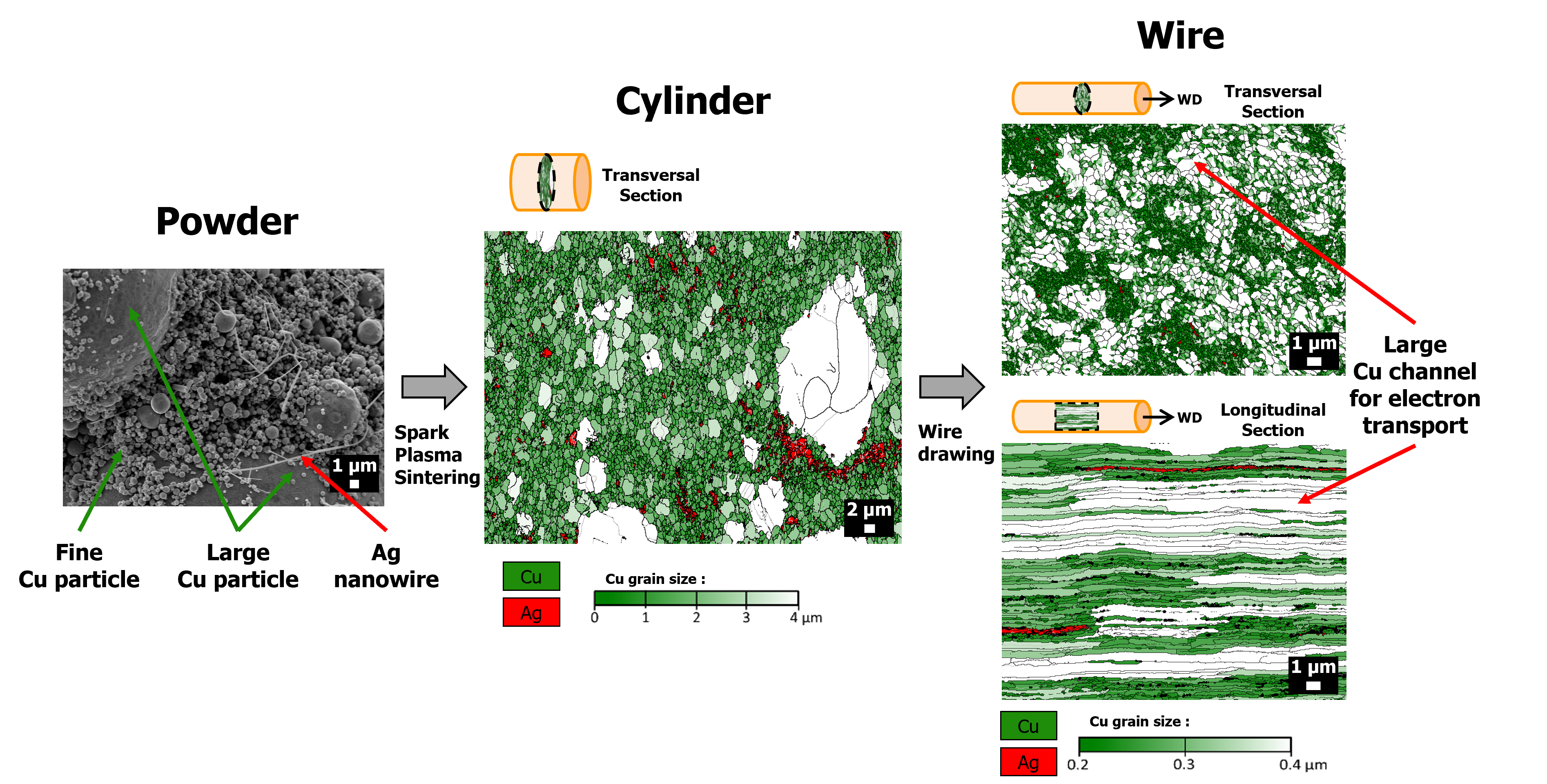Simon Tardieu, Florence Lecouturier-Dupouy, LNCMI Toulouse, and Christophe Laurent, Université de Toulouse.
The generation of record pulsed magnetic fields above 100 T requires the use of coils wound with low-resistivity wires in order to limit the heating, and with a very high mechanical strength in order to be able to resist the Lorentz forces. LNCMI and the Centre interuniversitaire de recherche et d‘ingénierie des matériaux (CIRIMAT) explore the design of novel silver-copper nanocomposite wires with the aim to break the usual strength-resistivity trade-off.
Composite powders are prepared by mixing 1 vol. % Ag nanowires (diameter 0.2 µm, length 30 µm, prepared in-house) and bimodal fine (1 µm) and large (20 µm) grain-size Cu powder with 50/50 and 75/25 in weight. The obtained composite powders are consolidated into cylinders (8 mm in diameter and 30 mm long) by spark plasma sintering (SPS). The cylinders served as starting materials for room-temperature wire drawing for the preparation of fine wires (1-0.2 mm diameter). The bimodal character of Cu is preserved after the preparation steps, namely after the preparation of the powder, the SPS cylinders, and the wires.
We show that it is possible to improve the low resistivity vs. high ultimate tensile strength (UTS) compromise of the composite wires by simply adding large grains of Cu during the composite-powder preparation step. Because they form large areas with few grain boundaries and no Ag, the larger Cu grains act as channels for good electron conduction, thus allowing to maintain a low electrical resistivity (0.45 μΩcm at 77 K). Compared to wires with only fine-grained Cu, this represents a 12 % lower electrical resistivity for the same UTS (1082 MPa at 77 K), which is provided by the finer Cu grains and the Ag nanowires. The strength-resistivity trade-off can be finetuned simply by adjusting the large grain / fine grain proportion.

Figure 1: Representation of the method and microstructure of the powder, cylinder, and wire samples. The powder was analyzed by scanning electron microscopy and the cylinder and wires by electron backscatter diffraction.

Figure 2: UTS vs. electrical resistivity at 77 K for wires with diameters from 1 to 0.2 mm for W50/50 (◆), W75/50 (⬛), and W100 (▲). The dotted lines are used to indicate wires with a diameter of 1 mm and the 0.2 mm wire in the case of W50/50
Influence of bimodal copper grain size distribution on electrical resistivity and tensile strength of silver-copper composite wires, S. Tardieu, D. Mesguich, A. Lonjon, F. Lecouturier-Dupouy, N. Ferreira, G. Chevallier, A. Proietti, C. Estournès, and C. Laurent, Mater. Today Commun. 37, 107403 (2023).
https://www.sciencedirect.com/science/article/pii/S2352492823020949
Contact: simon.tardieu@lncmi.cnrs.fr, florence.lecouturier@lncmi.cnrs.fr






